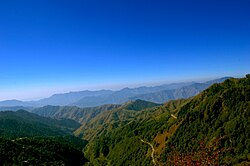| Special Frontier Force | |
|---|---|
| Founded | 14 November 1962 |
| Country | |
| Type | Special Forces Mountain warfare |
| Size | Classified |
| Part of | Cabinet Secretariat [1] |
| Headquarters | Chakrata, Uttarakhand, India |
| Nickname | Establishment 22, "Phantoms of Chittagong" |
| Engagements | |
| Commanders | |
| Notable commanders | Maj.Gen Sujan Singh Uban |
| Insignia | |
| Badge |  |
| Aircraft flown | |
| Helicopter | HAL Cheetah HAL Lancer |
| Cargo helicopter | Mi-17V-5 |
| Utility helicopter | HAL Dhruv HAL Chetak |
| Reconnaissance | IAI Searcher II IAI Heron DRDO Rustom |
| Transport | Gulfstream III Gulfstream G100 |
The Special Frontier Force (SFF) is a paramilitary Indian special forces unit composed primarily of Tibetan refugees and Gurkhas in India. It was established after the Sino-Indian War of 1962 to primarily conduct covert operations behind the Chinese lines in case of another war with China. Later it increased in size and scope of operations. [2]
Contents
- History
- British India precursor
- 1950s training with IB and CIA
- Formation
- CIA support and pull-out
- Battalions and composition
- Ranks
- Operations
- Pakistan
- China
- See also
- References
Throughout its history, SFF has fought in India's major external wars including the Bangladesh Liberation War and the Kargil War. It has also been involved in internal security, including Operation Blue Star and also serving as the "Personal Force" of Prime Minister Indira Gandhi to suppress opposition parties during the state of emergency from 1975 to 1977. [3] It has been part of border operations against China, including the 2020–2021 China–India skirmishes. [2]
Based in Chakrata, [4] Uttarakhand, the force was put under the direct supervision of the Intelligence Bureau (IB), and later the Research and Analysis Wing (R&AW), India's external intelligence agency, [5] and is not part of the Indian Army but functions under their operational control with its own rank structure, charter and training infrastructure. [6] It falls under the authority of the Directorate General on Security in the Cabinet Secretariat headed by an Inspector General (SFF) who is selected from the Major General rank of the Indian Army and who reports directly to the Prime Minister's Office. [1]








